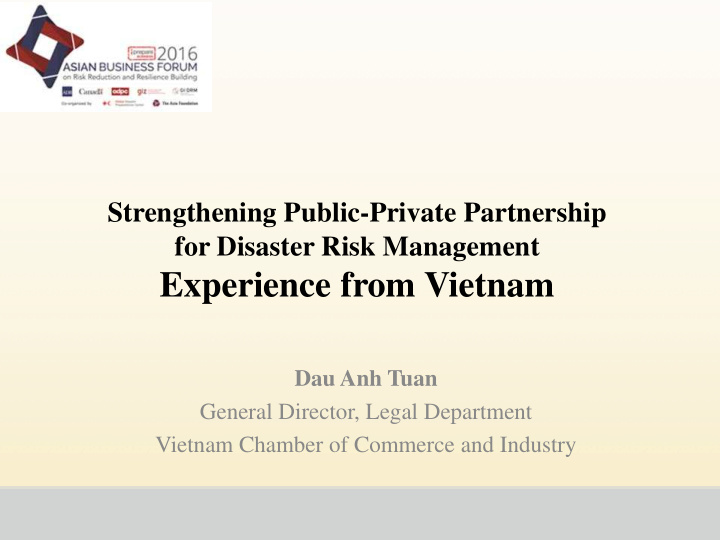



Strengthening Public-Private Partnership for Disaster Risk Management Experience from Vietnam Dau Anh Tuan General Director, Legal Department Vietnam Chamber of Commerce and Industry
Disaster in Vietnam • One of the most 5 heavily affected countries in the world • Account for 1,5 % GDP/year, hundreds of deaths and loss • 70% of population incurred by disaster risk • Occur with high frequency with more severe and complicated developments
Economic losses versus GDP growth in Vietnam Source: Mai Trong Nhuan et al.
WHY BUSINESS? • > 400,000 enterprises • 97% SMEs --- 40% GDP with 50% of Vietnam labor force. • Provide jobs, income, and services important for the development of vibrant communities. • Their ability to bounce back, re-establish production is a critical determinant of both local community and the country’s resilience to climate change.
Disaster’s damage to Vietnam SMEs • 85% of enterprises hit by seasonal storms • 45% by floods • and 12% by cyclones and high tide (Survey 500 enterprises in central provinces conducted by VCCI and TAF in 2011 )
Recent extreme rainfall and flood in Quang Ninh province - Vietnam • VND 2,7 trillion loss (>US$ 123 million) • Supply chain disruption: Coal Shortage for thermal power plants in other province – energy security • 30,000 employees temporarily stopped working for almost a month • Tourist sector: Halong Bay • Business continuity • Recovery: In-direct cost
How they are ready to cope with flood/storm ? Over 80% of businesses said they had no disaster planning, or plans only existed on paper Over 60% had no disaster risk insurance (Survey 500 enterprises in central provinces conducted by VCCI and TAF in 2011)
…and what did they get ? • 60% had incurred losses: 5% experienced significant damage and 30% indicated heavy loss • Important asset loss: 52% losses of physical structures; 47% losses of products; and 41% losses of equipment
…what do they think of ? • Most of them rely on the supports from the Government • Insurance is not an important factor • They thought the Government still keep key role in DRM in Vietnam • They claim Government on not adequately implementing its policies to support business to recover aftermath • They want to know more on DRM policy and more training on DRM
SO… • SMEs are vulnerable • They are generally poorly prepared • These factors potentially undermine the ability of communities to bounce back quickly from disaster • However, conditions vary across the country and engaging with these issues must take into account the character of local disaster risks and business culture
VCCI-TAF’s Public-Private Partnership initiative (2011-2014) Objective : To build effective and sustainable disaster response in Vietnam through: • Strengthening of public-private partnerships for disaster risk management; • Capacity building of small and medium enterprises to prepare for and respond to disasters; • And promotion of disaster-related corporate social responsibility initiatives
Approach Building institutional linkages between government, business and • community : Vietnam Chamber of Commerce and Industry (VCCI) works with TAF, professional business associations, SMEs, NGOs, Disaster Management Center, and local governments; Building capacity for businesses to analyze disaster risk and • implement disaster planning in provinces Promoting Private Sector Engagement in CSR targeting DRM • activities
Some results: • More than 2,000 managers from 1,200 businesses in 14 provinces were trained. • PPP at provincial level has been developed. • DRM policy dialogues with government has been frequent conducted • Communication strategy
Lessons from implementation • SMEs often have: – Short time horizons – Low management capacity – Have adapted to disaster risks without formal planning • Identification of disaster risk is not sufficient to ensure interest in disaster risk planning – For areas that experience regular, predictable flooding adaptation may be built in to business operations – Areas that are experiencing a change such as a larger number or more intense storms may be more likely to lead to interest
Thank you!
Recommend
More recommend